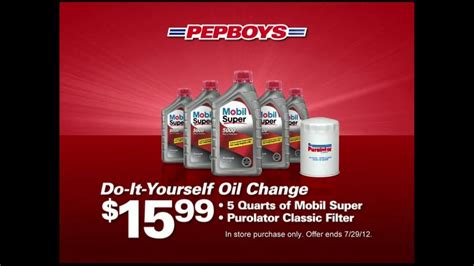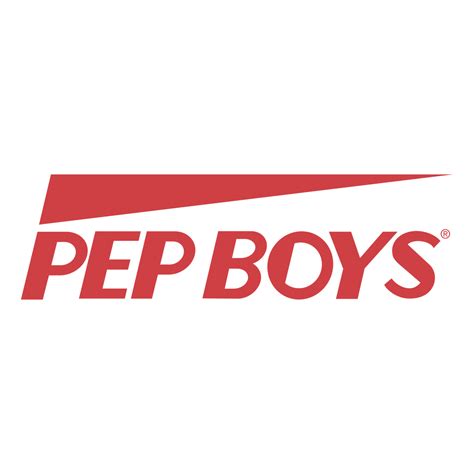What is PepBoys Do It Yourself Oil Change?

Pep Boys is a well-known automotive store that offers a wide range of services. One of those services is the Pep Boys Do It Yourself Oil Change, which is a popular service for drivers who prefer to take care of their car maintenance by themselves.
The Pep Boys Do It Yourself Oil Change service offers customers the opportunity to change their own oil in a safe and convenient environment. Pep Boys provides all the necessary tools and equipment and their knowledgeable staff is always available to offer assistance and guidance, should customers need it.
Customers who take advantage of this service can choose from a variety of oil brands and types, including synthetic, high mileage, and conventional oil. This flexibility gives drivers the freedom to choose the oil that best suits their driving style and individual needs.
The process of doing a DIY oil change at Pep Boys is simple and straightforward. Customers drive their car into a designated area, where they can safely change their oil without worrying about spills or safety hazards. Pep Boys also provides a safety inspection of the vehicle to ensure that everything is in good condition before driving away.
The Pep Boys Do It Yourself Oil Change service is an excellent option for drivers who prefer to take care of their own car maintenance. With a safe and convenient environment, the availability of a variety of oil options, and helpful staff, customers can rest assured that their car is in good hands.
Frequently Asked Questions about pepboys do it yourself oil change
What you will need may vary between vehicles, but some of the most common oil change equipment and supplies are listed here:
- Motor oil + oil filter.
- Wheel ramps + chocks.
- Safety glasses + gloves.
- Ratchet + socket set.
- Oil filter wrench + torque wrench.
- Funnel + oil pan.
- Clean rags + newspaper.
An Oil Change is the act of removing the used oil in your engine and replacing it with new, clean oil. Over time, oil breaks down and gets dirty. These factors make oil much less slippery and less effective at their job of lubricating engine parts.
How to Change Your Oil
- Step 1: Jack It Up, Open It Up. First, you'll want to lift the car high enough to give yourself room to work under it.
- Step 2: Unplug It, Drain It.
- Step 3: Off With the Old Filter.
- Step 4: Drain Plug in, Filter On.
- Step 5: Fill It Back Up with Oil.
- Step 6: Check the Oil Level, Check for Leaks.
You Save Money
Obviously, when you buy your own parts and provide your own labor, it is cheaper to change your own oil. But your time is money, too; when you don't have to take your vehicle to a dealership or auto body shop, you're saving yourself a commute and a boring wait.
10-Step Oil Change Instructions:
- Raise the vehicle.
- Position catch pan and remove plug.
- Inspect vehicle while all oil drains.
- Reinstall drain plug and torque.
- Remove old oil filter.
- Clean mount and remove old O-ring.
- Lube new filter and attach by hand.
- Remove oil fill cap and add new oil.
They will generally include the following items:
- Engine oil, in quart bottles (in the correct viscosity and quantity based on your vehicle's owner's manual)
- A high-grade oil filter that meets, or exceeds, the OEM requirements for your vehicle.
- The correct sized crush washer for your vehicle.
- A disposable funnel.
There are generally four types of oil to choose from: conventional, synthetic, high mileage, and blended oil. Each has its own unique set of properties, advantages, and drawbacks, so it's essential to understand their differences to make an informed decision.
An oil change is the process of removing and replacing the viscous fluid- otherwise known as oil- that runs through an internal combustion engine (aka the type of engine in a vehicle). The parts inside the engine move incredibly fast, which generates both friction and heat.
Some people like to do DIY oil changes to save money and learn more about their car. The process is relatively simple and takes anywhere from 30 minutes to an hour, depending on your experience level and comfort with the process.
It keeps your components clean and lubricated, and it's especially important to time it right the first time. That's because when the vehicle was manufactured, the mating surfaces scratched against each other, and metal particles that resulted need to be flushed out and removed so they don't damage the engine.
A clean oil filter helps maintain proper engine lubrication by removing contaminants from the oil that could otherwise cause friction and wear. This means better overall engine performance, including smoother acceleration, more responsive handling, and improved fuel efficiency.
To better understand what involves a full-service oil change, most will include the following steps:
- Step 1: Changing the Oil.
- Step 2: Checking Your Air Filter.
- Step 3: Checking Your Coolant/Antifreeze Levels.
- Step 4: Checking Your Power Steering Fluid.
- Step 5: Checking Your Brake Fluid.
Steps for changing your oil
- Check the type and amount of oil needed.
- Get together your filter, wrenches, and other supplies.
- Prepare your vehicle.
- Locate the oil filter and drain plug.
- Drain the oil.
- Tighten the drain plug.
- Change the oil filter.
- Add the new oil.
Crude oil is a mixture of comparatively volatile liquid hydrocarbons (compounds composed mainly of hydrogen and carbon), though it also contains some nitrogen, sulfur, and oxygen. Those elements form a large variety of complex molecular structures, some of which cannot be readily identified.
The SFSK oil analysis kits contain the equipment for sample extraction from the STAUFF test coupling or directly from a container or oil tank. To do this, the supplied hose is connected directly to the test coupling using an adaptor and the fluid is filled into the supplied sample bottle.
Synthetic Motor Oil: Best for Engine Protection
Although it originates as crude oil (just like conventional oil), full synthetic oil is highly refined and contains far fewer impurities than conventional oil.

















